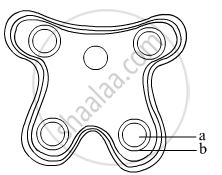Advertisements
Advertisements
प्रश्न
Draw a diagrammatic sectional view of a mature anatropous ovule and label the following parts in it:
(i) that develops into seed coat.
(ii) that develops into an embryo after fertilization.
(iii) that develops into an endosperm in an albuminous seed.
(iv) through which the pollen tube gains entry into the embryo sac.
(v) that attaches the ovule to the placenta.
उत्तर

i. The part that develops into seed coat− Integument
ii. The part that develops into an embryo after fertilization − Embryo sac
iii. The part that develops into an endosperm in an albuminous seed − Nucellus
iv. The part through which the pollen tube gains entry into the embryo sac − Micropyle
v. The part that attaches the ovule to the placenta− Funicle
APPEARS IN
संबंधित प्रश्न
What is meant by monosporic development of female gametophyte?
Differentiate between integument and testa.
In the T.S. of a mature anther given below, identify "a" and "b" and mention their functions.

Given below is the diagram of a human ovum surrounded by a few sperms. Study the diagram and answer the following questions :

(a) Which one of the sperms would reach the ovum earlier?
(b) Identify 'D' and 'E'. Mention the role of 'E'.
(c) Mention what helps the entry of sperm into the ovum and write the changes occurring in the ovum during the process.
(d) Name the specific region in the female reproductive system where the event represented in the diagram takes place.
The most common type of ovule is ______.
Embryo sac is found in ______.
What is the function of filiform apparatus in an angiospermic embryo sac?
Mature ovules are classified on the basis of funiculus. If micropyle comes to lie close to the funiculus the ovule is termed as ______.
During megasporogenesis, potential megaspore mother cell undergoes following cell divisions to form gametophyte female ______
Filiform apparatus is a highly thickened structure commonly present in ______.
